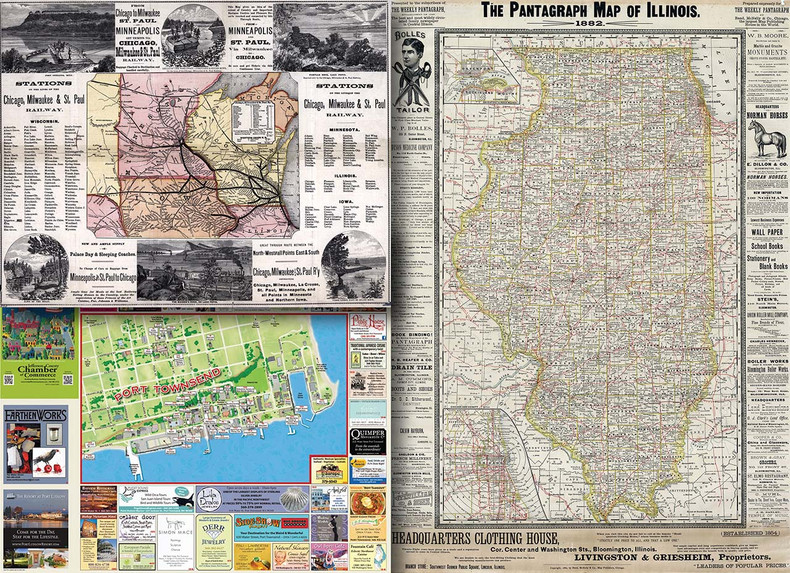Lost in longitude or confused by contour lines? Want to know all the tips and tricks to get the most from your atlas? Curious if paper towns still exist? "Ask a Cartographer" is your opportunity to get the facts straight from the source. Tom Vitacco, Rand McNally Publishing’s Director of GIS is here to answer your burning questions, and geek out over fascinating map lore – one exploration at a time.
This week, we are discussing how the company used to advertise our products back in the day…
Question: I am a longtime fan of Rand McNally and I remember seeing your magazine and newspaper ads when I was younger. Do you still create ads for your products?
Tom’s answer: Thank you! If you routinely follow this blog, you know that I have been a cartographer for many decades and do not have any marketing or advertising background outside of being exposed to some of these processes during my entire career.
However, I will try to answer the question to the best of my knowledge, although some of what I am writing is my interpretation of what was happening at the time. My plan is to highlight the variety of advertisements from a few different eras in company history, starting from the very beginning through various decades in the 20th century, and offer my thoughts on what the marketing team was trying to convey at the time.
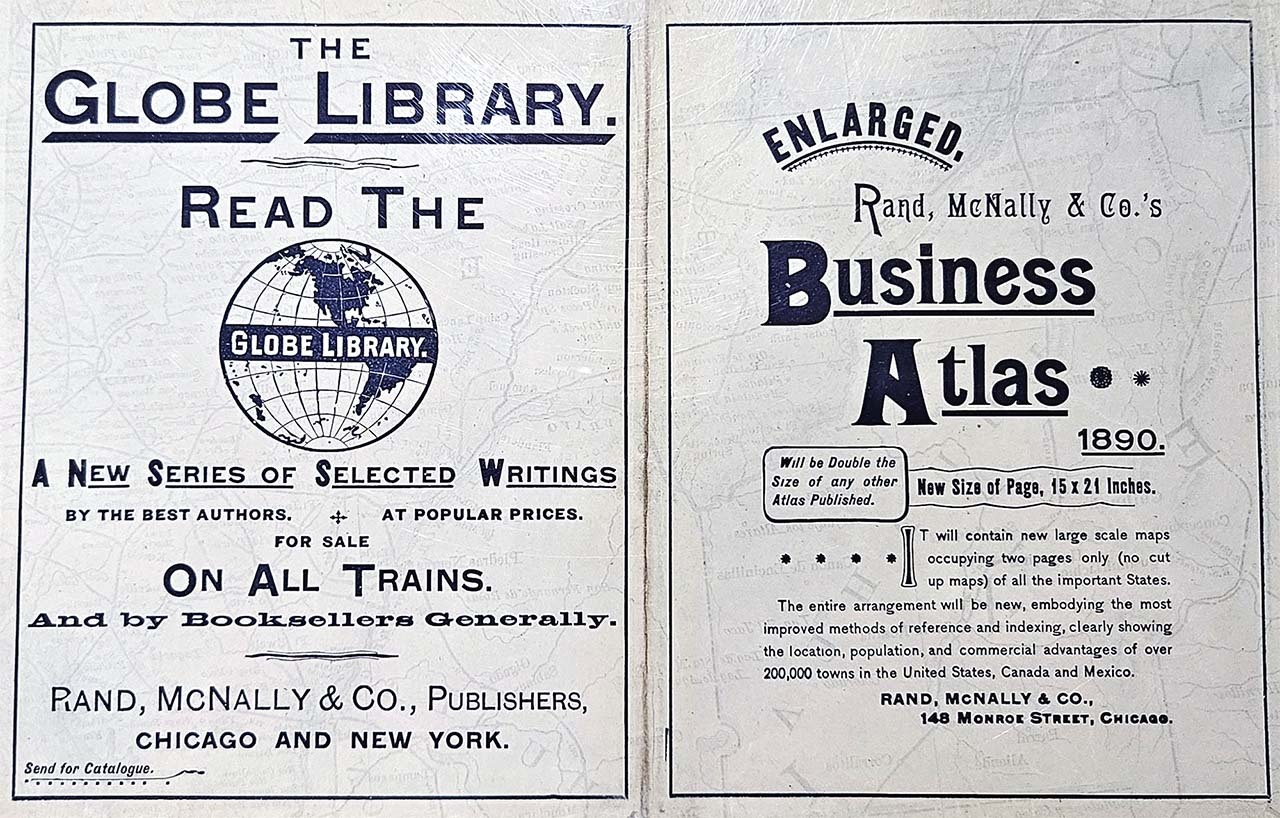 Pictured: Examples of early Rand McNally advertisements from an 1890 Railroad Guide.
Pictured: Examples of early Rand McNally advertisements from an 1890 Railroad Guide.
Before I begin, I would like to say thank you again to Steve Wiertz, a Senior GIS Analyst here at Rand McNally Publishing, for providing some of the content and images related to Rand McNally’s history of advertising. Steve has become our resident historian and his contributions to this blog have been extremely helpful.
In the beginning…
Maps and advertising have a long history together and Rand McNally realized the power of combining the two during the early days of the company in the late 1800s. The company often included their own advertisements within their railroad guides that featured maps and other information, or they produced stand-alone maps with ads from other companies and businesses adjacent to the frame. You can see examples of both in the image below, including a railroad map centered with information around the outside, plus a map of Illinois from a newspaper fully surrounded by advertisements.
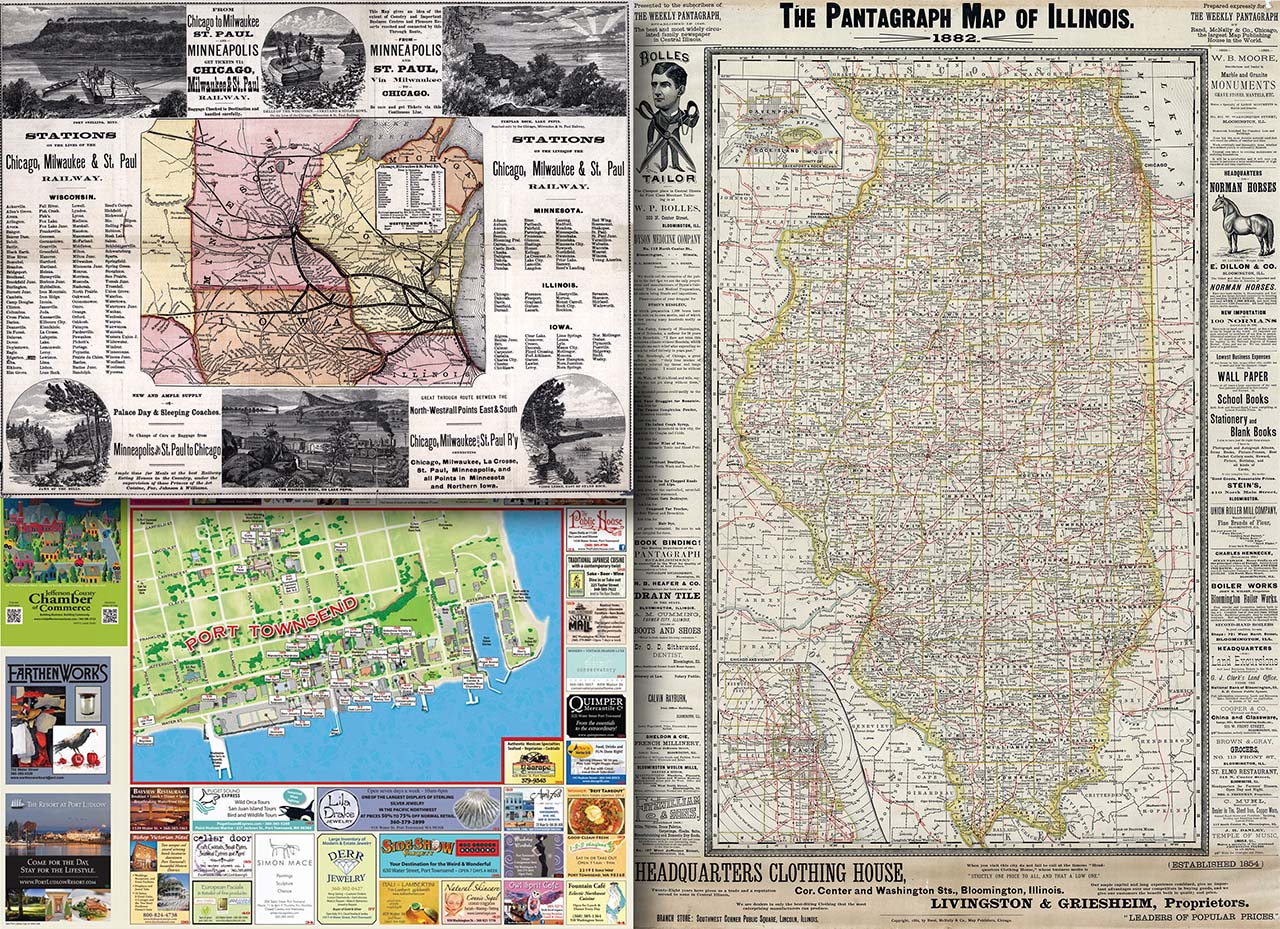 Pictured: Old railroad maps from the late 1800s with information and ads surrounding the map similar to Chamber of Commerce maps today.
Pictured: Old railroad maps from the late 1800s with information and ads surrounding the map similar to Chamber of Commerce maps today.
This type of layout was quite common in those days and is still used today on maps built by Chambers of Commerce, tourism departments, and even some State Department of Transportation maps. As a quick side note, before I started my career at Rand McNally in 1986, I did an internship at a small mapping firm in the suburbs of Chicago called Cartographic Services. My first job during the internship was to work on Chamber of Commerce maps that looked remarkably similar to the map shown in the image above.
Another example from this time period is shown below. The Pocket Map of Utah (see image below) was a typical Rand McNally map produced in the late 1800s that was small enough to fit in your pocket, but unfolded to a larger size. The Utah map also included an advertisement for the Phoenix Hotel, which I am sure generated extra revenue for the company.
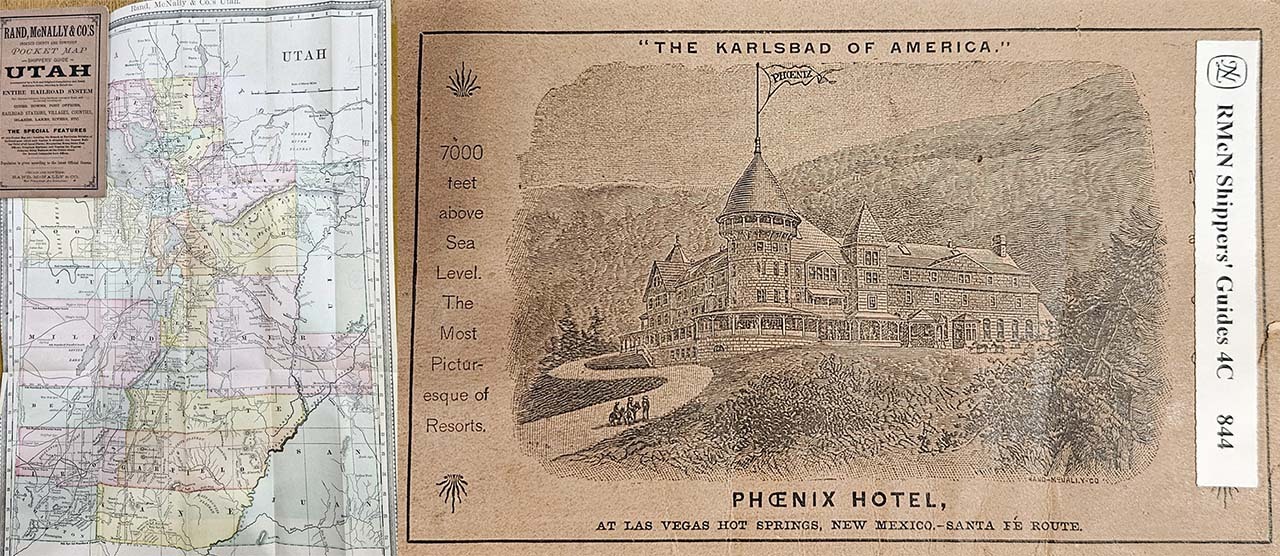 Pictured: The 1895 Rand McNally & Co’s Pocket Map of Utah and the Phoenix Hotel ad. Images courtesy of the Newberry Library.
Pictured: The 1895 Rand McNally & Co’s Pocket Map of Utah and the Phoenix Hotel ad. Images courtesy of the Newberry Library.
Turn of the Century
In the early 1900s, Rand began advertising their products heavily in newspapers, magazines, and even posters or other promotional formats. One thing I noticed about the ads from this era is they were written like “mini stories.” The marketing and editorial teams would often write a few paragraphs about whatever product or service they were trying to sell in a story format and usually included a form the customer could fill out and mail in to purchase the item.
 Photo: Some company advertisements produced in the early 1900s.
Photo: Some company advertisements produced in the early 1900s.
You can see some examples in the image above, where the ads almost appear like an article from a newspaper or magazine. Rand McNally still produced the usual type of advertisements as well, like the Auto Trails Maps ad from 1919 (far left) or the small newspaper clipping entitled “We Furnish Maps” (floating in the middle above) - which was straight to the point! The company even developed posters like the colorful Auto Road Maps graphic (center above) since travel by car was really starting to grow after the turn of the century. For me, the creativity of the marketing and design teams back then was evident based on the variety of formats and mediums they utilized.
The Cartoon Era
During the 1940s, Rand McNally collaborated with some of the leading cartoonists and illustrators at the time to produce creative drawings for weekly or monthly advertisements. The cartoonists, artists, and illustrators included Tony Barlow, Richard Decker, Richard Taylor, Whitney Darrow Jr., William Steig, and Gluyas Williams to name a few. Their work was often featured in major magazines and newspapers including The New Yorker, the Boston Globe, Life Magazine, and many more. Some even had long-running comics for a variety of industries, including everyday items like bar soap and hotel chains. To this day, we have some hand-drawn comic illustrations that mention Rand McNally hanging on the walls in our corporate office.
 Pictured: Advertisements from the 1940s drawn by famous illustrators at the time.
Pictured: Advertisements from the 1940s drawn by famous illustrators at the time.
Mid-Century Modern
Around the middle of the century, the company shifted the marketing focus to a “discovery theme” based on the ads I reviewed from that time period. Some examples are shown below, and you will notice the headline of each ad promotes how using Rand McNally products will help you “discover” new places or “discover” how their services can assist you or your company. After reviewing a lot of old ads, it became obvious to me that marketing was important to the company and each decade introduced a new era of promotional material and unique styles.
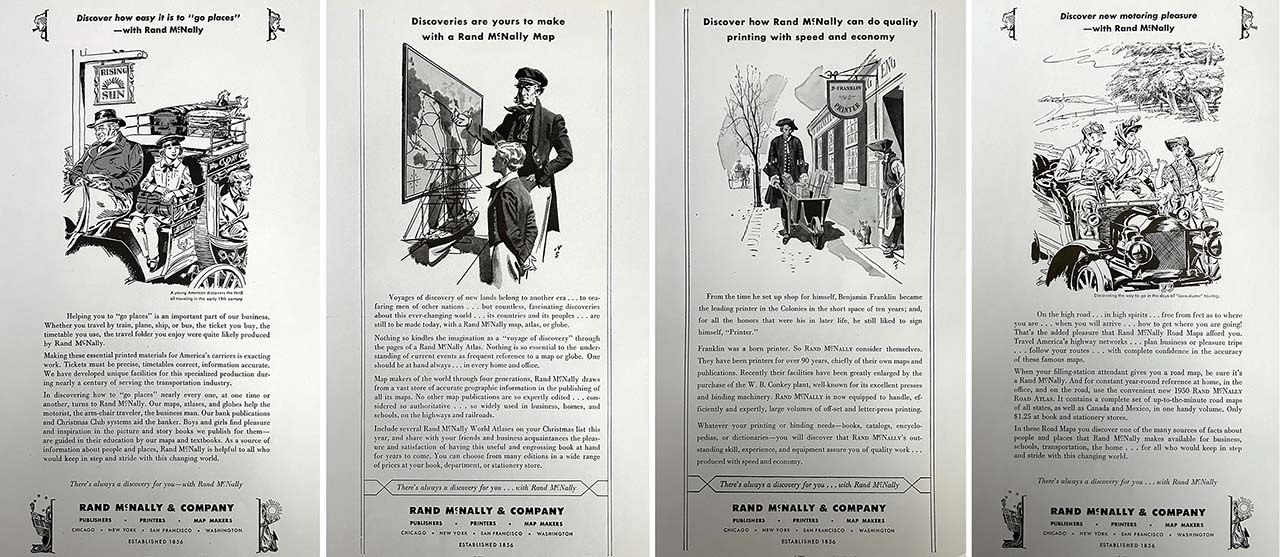 Pictured: Advertisements from the 1950s often featured the theme of discovery.
Pictured: Advertisements from the 1950s often featured the theme of discovery.
The Cultural Decades
I was born in the 1960s and recall some of our family trips during the late 1960s and early 1970s. Rand McNally advertisements started to promote family vacations and how their trusted and accurate road atlas products could help with your trip planning and navigation.
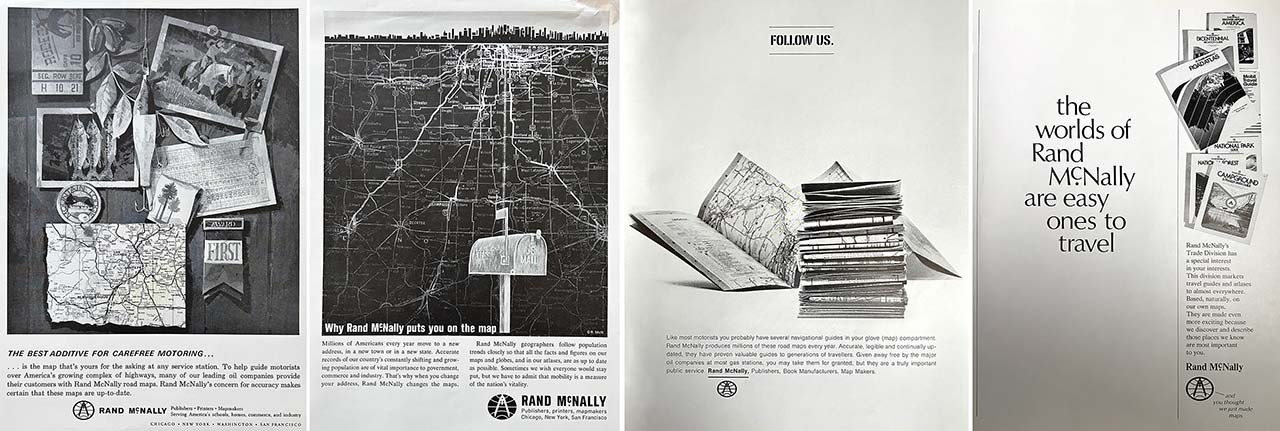 Pictured: Advertisements from the 1960s and 1970s focused on travel and the worlds of Rand McNally featured in magazines such as Time, Newsweek and U.S. News & World Report.
Pictured: Advertisements from the 1960s and 1970s focused on travel and the worlds of Rand McNally featured in magazines such as Time, Newsweek and U.S. News & World Report.
What stands out to me about the ads from this era is how they were almost poetic in nature and focused on a sense of adventure and wanderlust. The tag lines, such as “Follow Us” or “Get Lost!” or “Small world? Large Maps!” were imaginative and to the point. I really like how some of the ads included short phrasings that were topical and well-written. For example, here is the text from two ads created in 1968 that floated above a road image or a mountain scene:
"We can't promise you a feeling of wonderment, but we can help you find the place where, for you, it may still exist."
“28 miles to Interstate 88, turn off at Exit 6, go north on Route 14...it is a language learned young in a nation of travelers who read their course from a road map and plan vacations in an atlas. At Rand McNally, the knowledge and skill required to make our road maps and atlases clear and accurate are incredibly special capabilities. Though we are always updating and revising, once in a while someone still prefers to get lost.”
I personally like the ad below from 1970 because it reminds me of our family travelling in a station wagon or RV with stickers on the window from places you have been. The Rand McNally sticker and how the ad calls it out is clever and very appropriate for that time period from what I recall. I even came across some Rand McNally matchbooks from the 1970s which mention the Road Atlas on the cover and when you open the matchbook you got a small form to fill out and mail in to purchase a Road Atlas for under $2. Really cool stuff…just search on “Rand McNally matchbook” if you want to see examples.
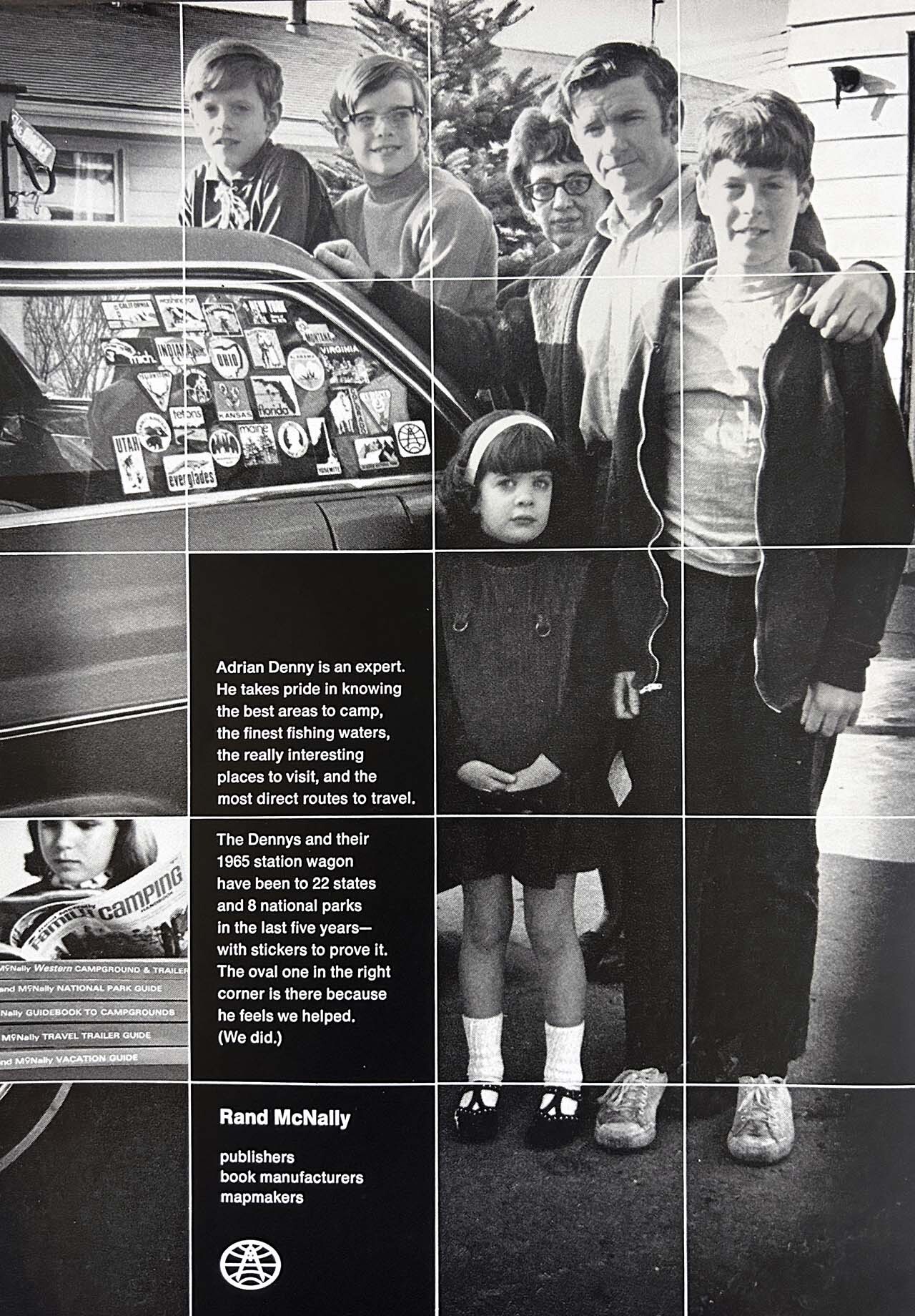 The End of the Century
The End of the Century
During the 1980s, Rand McNally produced many full page print ads for the Road Atlas and similar products, along with promotional sweepstakes in magazines focused on news, travel, and adventure. The company also offered large ad space within our products, like the back or inside covers of the Road Atlas, allowing other companies to advertise their goods and services for a fee of course. Most of those ads came from hotels or tire manufacturers from what I can remember, but I am sure there were other brands and products featured since the back of the Road Atlas was prime ad space with great distribution.
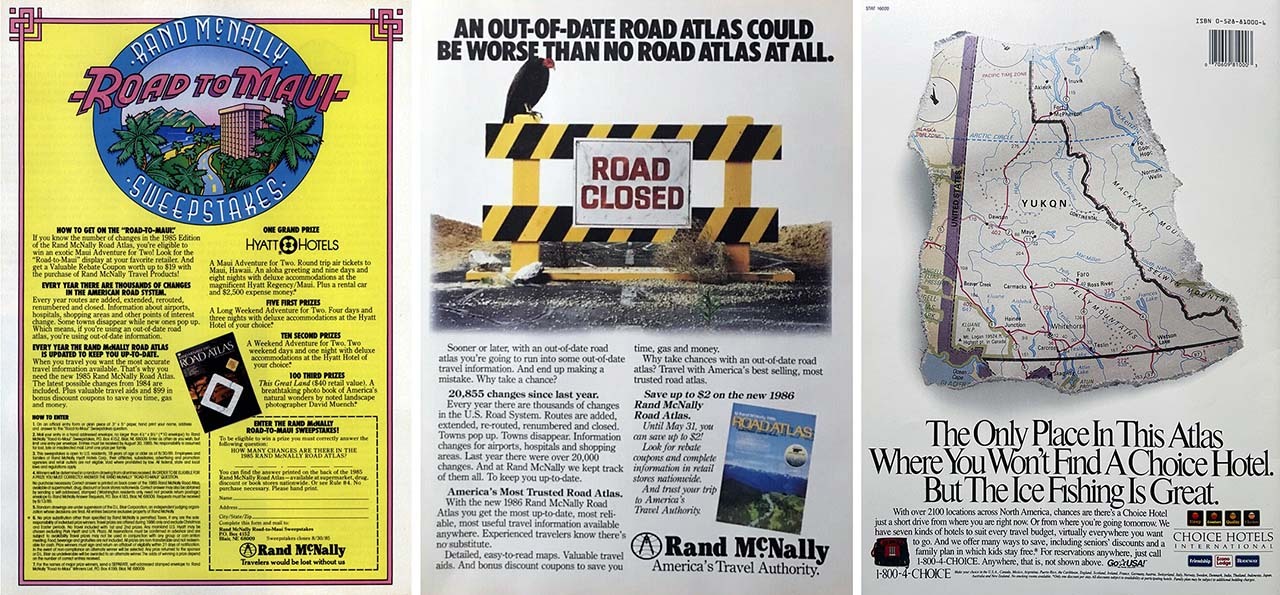 Pictured: Full page Road Atlas ads were common in the 1980s, along with sweepstakes and renting out the back cover space to other companies such as Choice Hotels.
Pictured: Full page Road Atlas ads were common in the 1980s, along with sweepstakes and renting out the back cover space to other companies such as Choice Hotels.
Advertising Today
The company does not advertise as much in print these days, but I wanted to mention a couple of video ads produced in 2013 for the RVND (our discontinued GPS specifically for RVers). The ads were only released on YouTube and used real actors cruising in their RVs looking for buried treasure with the RVND. I thought they were well made and funny at the time. You can search for them on YouTube if you are interested in viewing the commercials.
Today, we use social media and our website to promote our products, including the "Ask a Cartographer" blog you are reading now. Advertising has changed dramatically since the early print ads in the late 1800s, but the message remains the same. Rand McNally continues to produce the most trusted products for travelers as we have for more than 150 years.
Thanks again for the question! I hope I was able to portray the variety of advertising utilized by the marketing and design teams at Rand McNally over the years. The company realized the importance of advertising early on and was highly creative with their topical ads which were in tune with the cultural climate in the country at the time.
Feel free to submit your map or cartography questions below and check back soon for another installment of "Ask a Cartographer".
Have a question for our cartographer? Email us at printproducts@randmcnally.com with “Ask a Cartographer” in the subject line and your question could be featured next!


